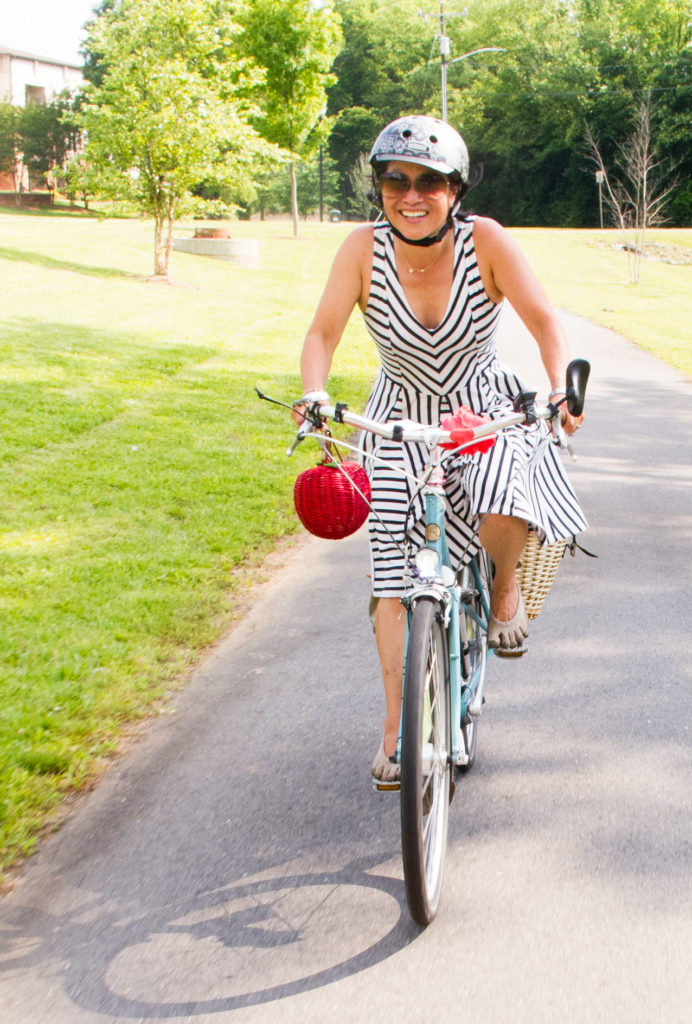Today I led another bike ride for Walk Oakland Bike Oakland (WOBO). WOBO is the lead sponsor of the Paint the Town program, which gives groups the opportunity to collaborate on painting an intersection or street. The city waives permit fees and provides a small bit of funding, and the neighbors work together to come up with a design and do the project. It’s a pretty cool program, inspired by City Repair in Portland. I’d done a ride to visit a number of Portland’s projects, and doing a similar ride in Oakland seemed like a fine idea.
The ride got postponed twice because of November’s smoke, but we managed to find a break in the rain in December to run it. It turned out to be a fine day for a ride, and we got to visit a number of interesting projects, some connected with businesses, some with schools, and others purely grassroots efforts by neighbors.
We were fortunate to be joined by Gordon Douglas, professor of urban design at San Jose State, and author of “The Help Yourself City: Legitimacy and Inequality in DIY Urbanism“, an ethnography of people working on DIY urbanism projects which investigates some of the themes of inclusion and exclusion that we were discussing on the ride.
We started with a stop by the White Horse Inn, the oldest gay bar in the U.S. where we talked about the significance of a former speakeasy, which did not even have windows for the first 60 years of its existence, now spilling out into the shared space of Telegraph Avenue. I talked about Henri Lefebvre’s concept of representational space, and Richard Florida’s neoliberal co-option of gayness as a tool of economic development.
I didn’t think about this until later, but Michel Foucault was another important French philosopher whose work about space, meaning, and power dynamics was hugely influential. Foucault was a gay man who died in 1984 after contracting AIDS while a visiting professor at Berkeley, and he almost certainly spent time at the White Horse.
Our second stop was an impressive neighborhood project on Ayala, where we had the luck to run into Courtney, a resident who’d worked on the mural. She shared with us the story of the neighborhood coming together to develop the mural, which was intended to slow down the cut-through traffic at the uncontrolled 3-way intersection. She said the traffic calming was only moderately successful, but she was really happy about community-building inspired by the project. Neighbors spent more time talking about this project than anything else they’ve done together. “And every time I walk by it I smile.”
From there we made the transition from Lower Rockridge, through the Idora Park and Golden Gate neighborhoods to McClymonds (West Oakland), where we visited a very cool mural and pedestrian safety project on San Pablo Avenue near the California Hotel. (To highlight the fact that this neighborhood’s life and safety issues are very different than Rockridge’s, a guy in a Firebird did a donut in the middle of the intersection as we were having our discussion.)
The California Hotel was built as a full-service hotel, and when it opened in 1929 it would not rent rooms to blacks (that policy changed in 1953), but it did have a music venue where many prominent black artists played, and the mural does a good job of highlighting the place’s contribution to music in the Bay Area.
From there we headed to Northgate, where a resident suggested a hummingbird design because hummingbirds are small but strong, like the local community.
Then we had a long run around the lake and along the waterfront to Jingletown, where Oakland’s first on-street murals sprouted back in 2007. These were do-it-yourself urbanism projects led by a local working artist, and they pose the question of how changes to the city become sanctioned and normalized. Marginal communities do transgressive things in urban space, as we saw at our mini-sideshow in West Oakland, but some of those become mainstream (like skateboarding, and Bike Party), while others become criminalized (like sideshows). Who gets to decide?
At our last stop, ASCEND Elementary, we saw most of a mural that was designed and implemented by middle-school students. Most of, because there was an event going on, and for some reason two police SUVs with lights on parked on the mural.
We also talked about the places in Oakland we didn’t ride: East Oakland and the foothill areas (Dimond, Laurel, Eastlake, Glenview: District 2). We had to skip East Oakland just because of time constraints; there are several cool murals there, including the first completed Paint the Town project at Arroyo Creek. (I was bummed to skip it, because East Oakland is excluded all too often).
But we skipped District 2 because there were no Paint the Town applications in those neighborhoods. I don’t have a solid theoretical explanation for that, but I find it interesting, and I do have a hypothesis. Those are some of the most diverse neighborhoods in the city: majority-minority, with many distinct communities within each broad ethnic group. My hypothesis is that volunteer community projects require relatively congruent values among the collaborators, and it’s easier to get to agreement when the community is more homogenous. Gordon shared that he had considered applying for a Paint the Town mural in his neighborhood, but was unsure how to approach it without feeling like he was trying to impose his own (white, male) vision on his non-white and non-male neighbors.
And that’s really the problem the Bike Lab is concerned with. We start with bike infrastructure models developed in homogenous Northern European countries, models with deep connections to the value systems of those places, and that’s a lot of why bike infrastructure has become associated with whiteness in the U.S. How do we break down that perception?
There’s not a simple response to the problem. But I do know that addressing it requires listening skills and humility.








